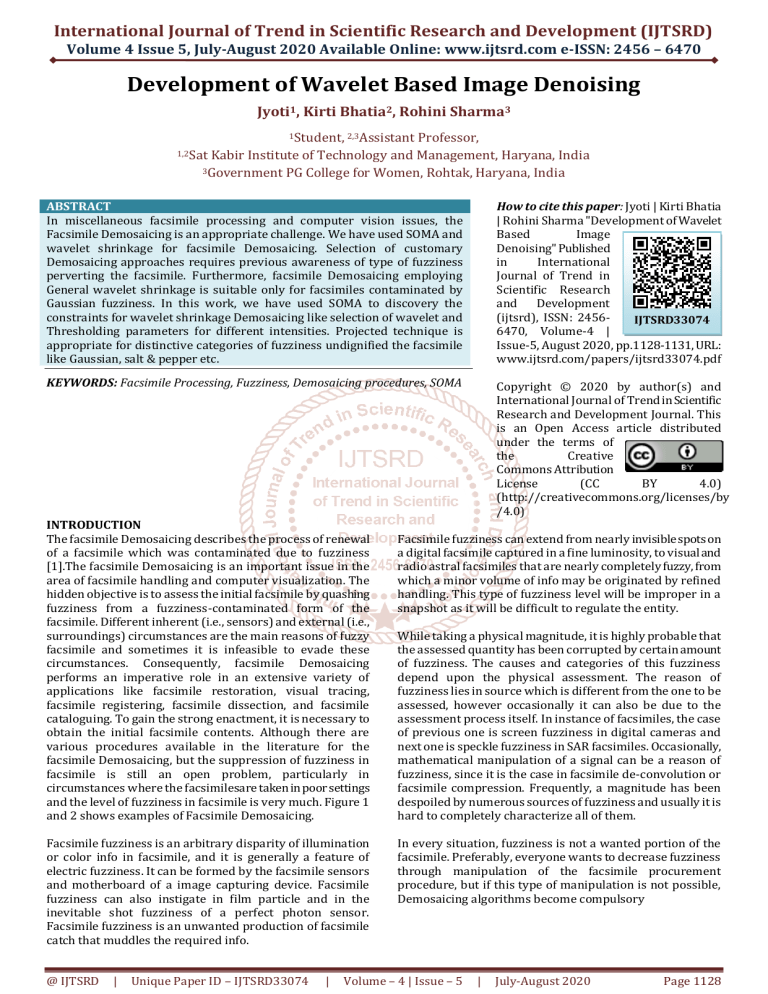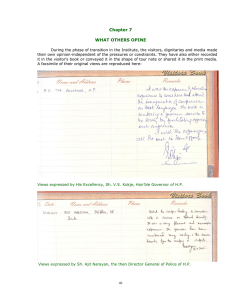
International Journal of Trend in Scientific Research and Development (IJTSRD) Volume 4 Issue 5, July-August 2020 Available Online: www.ijtsrd.com e-ISSN: 2456 – 6470 Development of Wavelet Based Image Denoising Jyoti1, Kirti Bhatia2, Rohini Sharma3 1Student, 2,3Assistant Professor, Kabir Institute of Technology and Management, Haryana, India 3Government PG College for Women, Rohtak, Haryana, India 1,2Sat ABSTRACT In miscellaneous facsimile processing and computer vision issues, the Facsimile Demosaicing is an appropriate challenge. We have used SOMA and wavelet shrinkage for facsimile Demosaicing. Selection of customary Demosaicing approaches requires previous awareness of type of fuzziness perverting the facsimile. Furthermore, facsimile Demosaicing employing General wavelet shrinkage is suitable only for facsimiles contaminated by Gaussian fuzziness. In this work, we have used SOMA to discovery the constraints for wavelet shrinkage Demosaicing like selection of wavelet and Thresholding parameters for different intensities. Projected technique is appropriate for distinctive categories of fuzziness undignified the facsimile like Gaussian, salt & pepper etc. How to cite this paper: Jyoti | Kirti Bhatia | Rohini Sharma "Development of Wavelet Based Image Denoising" Published in International Journal of Trend in Scientific Research and Development (ijtsrd), ISSN: 2456IJTSRD33074 6470, Volume-4 | Issue-5, August 2020, pp.1128-1131, URL: www.ijtsrd.com/papers/ijtsrd33074.pdf KEYWORDS: Facsimile Processing, Fuzziness, Demosaicing procedures, SOMA Copyright © 2020 by author(s) and International Journal of Trend in Scientific Research and Development Journal. This is an Open Access article distributed under the terms of the Creative Commons Attribution License (CC BY 4.0) (http://creativecommons.org/licenses/by /4.0) INTRODUCTION The facsimile Demosaicing describes the process of renewal of a facsimile which was contaminated due to fuzziness [1].The facsimile Demosaicing is an important issue in the area of facsimile handling and computer visualization. The hidden objective is to assess the initial facsimile by quashing fuzziness from a fuzziness-contaminated form of the facsimile. Different inherent (i.e., sensors) and external (i.e., surroundings) circumstances are the main reasons of fuzzy facsimile and sometimes it is infeasible to evade these circumstances. Consequently, facsimile Demosaicing performs an imperative role in an extensive variety of applications like facsimile restoration, visual tracing, facsimile registering, facsimile dissection, and facsimile cataloguing. To gain the strong enactment, it is necessary to obtain the initial facsimile contents. Although there are various procedures available in the literature for the facsimile Demosaicing, but the suppression of fuzziness in facsimile is still an open problem, particularly in circumstances where the facsimilesare taken in poor settings and the level of fuzziness in facsimile is very much. Figure 1 and 2 shows examples of Facsimile Demosaicing. Facsimile fuzziness is an arbitrary disparity of illumination or color info in facsimile, and it is generally a feature of electric fuzziness. It can be formed by the facsimile sensors and motherboard of a image capturing device. Facsimile fuzziness can also instigate in film particle and in the inevitable shot fuzziness of a perfect photon sensor. Facsimile fuzziness is an unwanted production of facsimile catch that muddles the required info. @ IJTSRD | Unique Paper ID – IJTSRD33074 | Facsimile fuzziness can extend from nearly invisible spots on a digital facsimile captured in a fine luminosity, to visual and radio astral facsimiles that are nearly completely fuzzy, from which a minor volume of info may be originated by refined handling. This type of fuzziness level will be improper in a snapshot as it will be difficult to regulate the entity. While taking a physical magnitude, it is highly probable that the assessed quantity has been corrupted by certain amount of fuzziness. The causes and categories of this fuzziness depend upon the physical assessment. The reason of fuzziness lies in source which is different from the one to be assessed, however occasionally it can also be due to the assessment process itself. In instance of facsimiles, the case of previous one is screen fuzziness in digital cameras and next one is speckle fuzziness in SAR facsimiles. Occasionally, mathematical manipulation of a signal can be a reason of fuzziness, since it is the case in facsimile de-convolution or facsimile compression. Frequently, a magnitude has been despoiled by numerous sources of fuzziness and usually it is hard to completely characterize all of them. In every situation, fuzziness is not a wanted portion of the facsimile. Preferably, everyone wants to decrease fuzziness through manipulation of the facsimile procurement procedure, but if this type of manipulation is not possible, Demosaicing algorithms become compulsory Volume – 4 | Issue – 5 | July-August 2020 Page 1128 International Journal of Trend in Scientific Research and Development (IJTSRD) @ www.ijtsrd.com eISSN: 2456-6470 Further, the non-data adaptable transformation domain straining techniques can be partitioned into 2 fields, specifically spatial-frequency domain (use low band straining) and wavelet domain [5].Generally, when facsimiles is transformed using low band strainers, like using Fourier transformation, the information of facsimile largely disperses in the low frequency spectrum, whereas fuzziness disperses in the high frequency spectrum. Therefore, fuzziness may be removed through selection of precise transformation domain aspects and converting them again to the facsimile domain. Nevertheless, these approaches consume very time and rest on the threshold frequency and behavior of filter function. Being the well-known transformation of Demosaicing, the wavelet transformation [6] crumbles the input data into the presentation of scale-space. It is a well-known fact that wavelets can positively reduce fuzziness whereas maintaining the facsimile features, irrespective of its frequency gist [7]. Analogous to spatial domain straining, wavelet domain based filtering operations can be partitioned into direct and undirect approaches. As the wavelet transformation has numerous suitable features, like thinness and many-scale, still there is scope of further research in facsimile Demosaicing [8]. Though, the wavelet transformation profoundly depends upon the assortment of wavelet foundations. If the assortment is unsuitable, the facsimile presented in the wavelet domain cannot be expressed well and leads to inadequate Demosaicing impression. Consequently, this technique is not adaptable. Fig 1: Fuzziness in Facsimile Fig 2: Clean Facsimile Related Work: Many researchers have worked for transformation domain straining techniques. Contrary to spatial domain straining techniques, transformation domain straining techniques, initially alter the provided noisy Facsimile to different domain, afterwards Demosaicing technique has been applied on the converted facsimile rendering to the distinctive features of the facsimile and its fuzziness (bigger values shows upper frequency section, e.g., the particulars or boundaries of the facsimile and minor values shows the fuzziness). The transformation domain straining approaches can be partitioned rendering to the selected base alteration operations [2]. The ICA [3] and PCA [4] functions have been considered as the transformation means for the specified fuzzy Facsimiles. In case of Demosaicing non-Gaussian data, the ICA technique has been positively realized. The ICA and the PCA are the best data adaptable methods, and they hold the state on the alteration between the facsimile and fuzziness. Though, their key disadvantage is excessive computation rate as they employ sliding windows and need a section of fuzziness freed data or 2 facsimile frames from the similar sight. Though, in certain usages, it would be complex to achieve fuzziness-free sample data. @ IJTSRD | Unique Paper ID – IJTSRD33074 | Since the DWT concentrate the energy of the signal in small number of values, it is a mostly used in facsimile Demosaicing. Henceforth, the DWT of the fuzzy facsimile includes a small number of parameters consisting of high SNR whereas comparatively high number of parameters has little SNR. After the removal of the parameter with low SNR (i.e., fuzzy values) the facsimile has been recreated via inverse DWT. Consequently, fuzziness has been eliminated or strained from the interpretations [9]. A key benefit of Wavelet based techniques is that it offers time and frequency localization concurrently. Furthermore, these techniques describe the signals more proficiently than either the preliminary domain or converts through universal based components like the Fourier transform [10]. Figure 2 demonstrates Wiener Strainer in wavelet Domain. The transformation domain methods are primarily focused on wavelet transformation. Now fuzziness is presumed to be white and facsimile is free of the fuzziness. On the basis of the de-speckling, the Demosaicing procedures may be largely partitioned into two key sets: the homomorphism and nonholomorphic method. These methods have been presented in reduced and non-reduced wavelet domain. The benefit of employing non-reduced wavelets for Demosaicing signaling dependent fuzziness is similar to a TID which comprises of smearing wavelet Demosaicing to circularly moved types of the fuzzy facsimile and of averaging the outcomes after changing them again. Volume – 4 | Issue – 5 | July-August 2020 Page 1129 International Journal of Trend in Scientific Research and Development (IJTSRD) @ www.ijtsrd.com eISSN: 2456-6470 broad search of search space this factor should be allotted a value more than 1. Size of the Step: It determines the size of steps which are required by animals to navigate the path to the lead, in a single loop. At the cost of augmented computational time, a small value offers better outcomes. Pseudo code for Self-Organizing Migration Algorithm Produce an arbitrary primary populace Fig 2: Wiener Filter in wavelet Domain Proposed Method: We have used wavelet shrinkage and SOMA method for Facsimile Demosaicing. It can remove following types of fuzziness from facsimiles. Wavelet reduction Demosaicing is a prevalent technique for fuzziness elimination in facsimiles. For this technique, the selection of parameter relies upon the data of the initial facsimile and fuzziness. Generally these parameters are selected by hit and trial method. The original method presented for the valuation of threshold of wavelet shrinkage was the general threshold projected by Donohue. Though, this method is not suitable in all circumstances. In this work, we have used the Self-Organizing Migration Algorithm (SOMA) for discovery the optimum group of factors (kind of wavelet, level of decay and threshold) for wavelet shrinkage Demosaicing. The SOMA produces better excellence resolution, for numerous types of fuzziness (Gaussian, speckle and salt & pepper fuzziness), in a rational time period. Assessment of Demosaicing facsimile has been conducted through factors like PSNR, entropy and SSIM. It has been indicated that anticipated method gives high degree of fuzziness elimination as well as conserving the boundaries and other particulars of the facsimile. To feature particulars and develop disparity, it is necessary to do improvements in facsimiles in almost all facsimile processing areas like fault recognition, computer visualization, medicinal facsimile investigation and distant sensing. The procedure of facsimile improvement includes transferring an input facsimile into a shape which offers enhanced pictorial view and is additionally suitable for retrieval of information. SOMA, presented is an evolutionary algorithm [11] which takes motivation from activities of animals (for instance assemblage of aunts while hunting for food). Contrary to other evolutionary algorithms, it doesn’t include generating children in each generation. Rather a populace of animals travels in the search domain. Every creature has been described by its location which is revised in each relocation loop. A relocation loop of SOMA is same to a generation of genetic algorithms. Appropriateness of all individuals has been calculated and one with the maximum fitness befits the lead. All animals’ travels to the lead in every relocation loop. Other than the magnitude of problem and the populace volume, the factors which control the mechanism are as follows: Path Length: It determines the location when a creature should halts while tracking the lead one. If the value of this factor is less than 1, animal halts one less point than the leads. If it is 1, animal halts at the same point of lead. If the value of this factor is more than 1, the animal goes beyond the location of the lead and surpasses the lead. To guarantee @ IJTSRD | Unique Paper ID – IJTSRD33074 | While close conditions are not fulfilled Calculate fitness of every creature Chose lead (creature with maximum fitness) For every creature (i) of the populace, While not path length Produce PRT vector Revise location of element Revise fitness value Chose a new lead End loop Gaussian fuzziness The key supplies of Gaussian fuzziness in digital facsimiles rise through attainment. The sensor has intrinsic fuzziness owing to the scale of brightness and its individual heat, and the motherboard linked to the sensor injects their individual portion of motherboard fuzziness. A distinctive prototype of facsimile fuzziness is Gaussian, additive, autonomous at every pixel, and free of the signal brightness, produced originally by Nyquist fuzziness, containing the changed fuzziness of kTC fuzziness.[12] Amplifier fuzziness is a key module of the stated fuzziness of an facsimile sensor, i.e., of the persistent fuzziness scale in dim sections of the facsimile.[13] In colored digital capturing devices, where additional amplification has been employed in the colored medium. There can be additional fuzziness in the blue medium. Salt-and-pepper fuzziness Fat-tail disseminated or impetuous fuzziness is occasionally known as salt-and-pepper fuzziness or prickle fuzziness. A Facsimile comprising salt-and-pepper fuzziness will have shady dots in illuminated areas and intense dots in shady areas. This sort of fuzziness may beinstigated by ADC transformer faults, fault in communication, etc. Generally, it can be removed through shady frame removal, median straining, mutual mean straining and interposing nearby dark and bright dots. Figure 3 shows complete process of wavelet Transform. Fig 3: Module Schema of Facsimile Demosaicing employing Wavelet Transform Volume – 4 | Issue – 5 | July-August 2020 Page 1130 International Journal of Trend in Scientific Research and Development (IJTSRD) @ www.ijtsrd.com eISSN: 2456-6470 Sampling Filter Figure 4 demonstrates the assembly of two phase sampling strainer in context of coefficients such that combination from rough scale to adequate scale. finest details that are hidden, obscure, and meager emphasis on the initial picture. REFERENCES [1] https://uwaterloo.ca/vision-image-processinglab/research-demos/image-denoising. [2] Jung A (2001) An introduction to a new data analysis tool: independent component analysis. In: Proceedings of workshop GK. IEEE, “nonlinearity”, Regensburg, pp 127–132. Fig 4: Two stage Sampling Filter Results We have used MATLAB for implementation. Figure 5 shows Lena.bmp after Demosaicing. [3] Muresan DD, Parks TW (2003) Adaptive principal components and image denoising. In: Abstracts of 2003 international conference on image processing. IEEE, Barcelona, pp I–101. [4] Mallat SG (1989) A theory for multiresolution signal decomposition: the wavelet representation. IEEE Trans Pattern Anal Mach Intell 11(7):674–693. [5] Gonzalez RC, Woods RE (2006) Digital image processing, 3rd edn. Prentice-Hall, Inc, Upper Saddle River. [6] Choi H, Baraniuk R (1998) Analysis of wavelet-domain wiener filters. In: Abstracts of IEEE-SP international symposium on time-frequency and time-scale analysis. IEEE, Pittsburgh, pp 613–616. [7] Yao XB (2014) Image denoising research based on nonlocal sparse models with low-rank matrix decomposition. Dissertation, Xidian University. [8] Chen YY, Pock T (2017) Trainable nonlinear reaction diffusion: a flexible framework for fast and effective image restoration. IEEE Trans Pattern Anal Mach Intell 39(6):1256–1272. Fig 5: Facsimile Demosaicing Result Conclusions In this work for computing the threshold level for spatial domain the Lena facsimile has been employed for execution. In case of Demosaicing, we conserve disparity of the picture. In Demosaicing, the Facsimile brightness remains similar however conserve the contextual and the gray level pitches in the picture. The sound word has been taken into account as an arbitrary event and it is not correlated, henceforth the regular value of the sound produces a zero value, consequently use exact kernel to acquire Demosaicing Facsimile The low bandwidth spatial filter decreases the distortion like connecting the breaks in the shapes of a given facsimile, though unsuitable for decreasing the distortion forms containing of robust confound such as modules. The high bandwidth filters produce fine particulars and yields @ IJTSRD | Unique Paper ID – IJTSRD33074 | [9] Arivazhagan, S. and Kannan, K. (2007). Performance Analysis of Image Denoising System for different levels of Wavelet decomposition. International Journal of Imaging Science and Engineering (IJISE), l.1(3). [10] Ram, I. and Cohen, I.(2011). Generalized Tree-Based Wavelet Transform. IEEE Transactions On Signal Processing, 59(9). [11] Zelinka, I. (2000). SOMA — Self-Organizing Migrating Algorithm. New Optimization Techniques in Engineering, 167-217. [12] Jun Ohta (2008). Smart CMOS Image Sensors and Applications. CRC Press. ISBN 0-8493-3681-3. [13] Junichi Nakamura (2005). Image Sensors and Signal Processing for Digital Still Cameras. CRC Press. ISBN 08493-3545-0. Volume – 4 | Issue – 5 | July-August 2020 Page 1131


